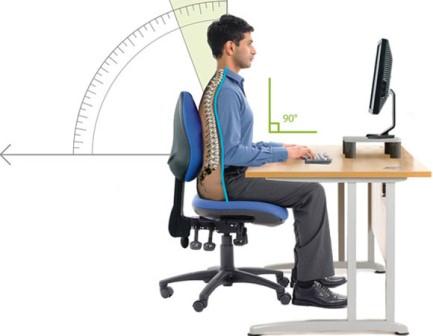Musculoskeletal Disorders in the Office Environment
While these problems are most common in industrial and manual jobs, office workers are also at risk of discomfort due to prolonged sitting, repeated movements and poor posture.
Musculoskeletal disorder (MSD) is any injury, damage or disorder to the joints or other tissues of the body. It usually affects the upper limbs or the neck or back, and can be caused or made worse by work activities such as using badly designed equipment or by poor work practices, such as poor posture when using equipment or taking insufficient breaks away from computer screens. These painful disorders can not only affect employees’ quality of life but can also impact business in terms of productivity.
In order to prevent employees developing MSDs, employers are required by law to carry out Display Screen Equipment (DSE) risk assessments and provide workers with suitable equipment and advice to eliminate or minimise the risk of discomfort or stress associated with computer work.
Identifying the issues
The majority of musculoskeletal complaints from employees in office environments concern the lower back, neck and upper limbs (shoulder, arm, wrist and hand). With these in mind, examples of key concerns in the office workplace include:
- a lack of awareness of ergonomics or musculoskeletal risk factors and appropriate prevention strategies
- provision of suitable equipment
- insufficient breaks resulting in strain on the body
- poor working practices, such as poor posture and not being able to touch type, which consequently result in stress or fatigue
- poor environmental conditions, such as problems with heating, lighting and ventilation
Making a difference
Under the Health and Safety (Display Screen Equipment) Regulations 1992 (amended 2002), employers have a duty of care to protect employees who work at computers for an hour or more at a time, by providing suitable equipment and advice on its use.
This includes desk-based equipment as well as mobile devices such as laptops, tablets and smartphones. The Display Screen Equipment Regulations specify requirements for equipment, and employers are required to assess what they provide against that.
It should be remembered that all employees are different, and some may need alternative chairs or specialist keyboards or mice; this would be identified in an assessment. Advice on what equipment or adjustments may be suitable can be provided by your C&C Advisor.
As well as providing the correct equipment, employers should also inform employees who work at a computer about the factors that can cause discomfort and how they can prevent discomfort associated with its use; for example, how to adjust their chair and other equipment and the importance of regular breaks.
The benefits
Assessing the ergonomic needs of employees working at computers, and providing appropriate equipment and advice can increase employee well being, may help reduce absence, and may result in business benefits such as increased productivity. These simple steps can have significant benefits for both the employer and employee











